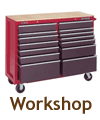
Copyright 2011. figNoggle Designs.
7x10, 7x12, 7x14 Mini-Lathe Information Website Links
Post a link to your website or view other hobby and machine and metalworking websites for free.
|
|
Rent Mill & Lathe DVDs at Smartflix | Great aluminum & steel prices at OnlineMetals
SIEG X2 MINI MILL
- MINI
MILL HOME
- DRO
- CNC V1 - CNC V2
- STUFFMADE - REDUX
- HOW-TOS
HOW-TO Make Acetal/Delrin Gib Strips
ok. why?
when you're really fine-tuning the motion of the mini
mill you'll find that table alignment, binding, uneven wear of the gibs
all affect the "handling" of the mill. if you've installed some form of CNC conversion and want to reduce as much friction
and backlash from the system one approach is to install acetal components
where possible.
the advantage
of acetal is that it is an easily machineable material that has "high"
mechanical strength and rigidity but also offers natural lubricity and is
dimensionally stable.
there are
tradeoffs however in using this material. with an upgraded acme leadscrew and acetal nut and the stock gib strip, we have found that in order to have the gibs
adjusted "just right" (i.e. no play) and maintain alignment throughout the
entire table travel distance, you have increased flex in the acetal nut
when leadscrew positively engages. this build up of "sticktion" and flex
leads to noticeable backlash on the order of 0.004"-0.010" (on average in
our tests). sometimes even binding occurs at the extremes of travel. to
us, things can be improved.
call us crazy (or obsessed with this acetal material!) but we want to
really get the mini-mill dialed-in as best we can using the cost-effective
acme leadscrew/acetal nut combination so the other factor in this equation
is the replacement of the stock gib strip with an acetal strip. here's how
we did it.
| the makings of the gib strip |
| first we need the dimensions of the existing strip.
it's the x-axis here. the length is 5.900".
we're going to be using natural acetal as the stock for the gib strip.
since there was no angle vise to use, we took the
shortcut of making the angle 45 degrees. this will offset the intended
contact patch significantly but this is a trial run of a prototype.
either an angle vise (or something similar) will
need to be used or we can fashion a cutter out of drill rod with the
appropriate specs. more on that later.
in short, a slitting saw was used (be sure to
check for vise clearance otherwise you'll end up bending your arbor like
we did - oops) to get the stock to the correct width.
then with the strip held in the vise, the v-cutter
was used to create the angle. simple as that! |
 |
| here's the gib strip holder being milled. note the
adjustable angle block being used to set the appropriate angle.
you can download the
free cad drawing for this holder by clicking here. |
 |
| here are the angle blocks used to determine the
appropriate angle for the gib strip. |
 |
| the strip is mounted in the holder which is in turn
mounted in the vise. |
 |
| this is interesting. this is the stock x-axis gib
strip tightened just right.
you can actually see that the strip does not make
full contact with the dovetail. look at the upper left corner of the
strip. there's a gap. the y-axis is the same.
the problem is not with the geometry of the gib
strips - it's how the set screws make contact with the strip itself. a
better way to force a good contact patchis to perhaps either change the
geometry (angle) of the strip and/or to change how the set screws contact
the strip itself.
this means that the acetal strips (since they're
based on the same dimensions as the stock gibs) will also have this
problem. |
 |
| results (short-term) |
| it works!
here are the
results and short term observations:
- there's less binding at extreme table travels
(with less adjustment to the strip than with the stock gib)
- hand cranking the handwheel is smoother than
with the stock gib strip
- motion is smoother when used with CNC (not a
scientific conclusion but you can listen to the motor and there appears
to be more constant sounds emitted)
- tightening the gib strip to lock the table in
position requires more turning of the lock screw (you would not want to
use the stock lever with this method as it would require many many turns
to lock the table in place)
- adjustment of the 4 set screws requires more
"feel" (since the acetal is more compliant of a material than the stock
gib)
- when coupled with the acetal nut/acme
leadscrew upgrade, there's less resulting backlash due to the "tightened
gib scenario".
we feel that this should be offered with
our upcoming acme leadscrew/acetal nut
kit - otherwise, the upgrade would only be partially beneficial. |
 |
|
|

Looking for mini-mill help and how-tos? How about lathe help and how-tos? We're prototyping a benchtop CNC vertical mill using the DigiSpeed-XL interface card for Mach, Dart Controls and KB Electronics KBIC/KBMM 90VDC motor controllers, 1.5HP treadmill motor from Surplus Center and a R8-spindle head from the X2 mini-mill - not to mention Gecko servo drives and an entirely closed-loop system. Come take a look!CNC 8x12 Lathe
Check out our newest developments like the CNC/DRO 8x12/8x14 lathe using Gecko drives, break-out board, NEMA 34 step motors, DRO and more!
SUPERX3.COM
Sieg X3 and Super X3 Grizzly G0463 Info MDAHacks.com
T-Mobile MDA / Cingular 8125 / HTC Wizard Hacks, Tweaks, Tips, Tricks and More!
Metal Working FAQ.NET
Your source for metalworking and machining, tips, tricks, and more. Over 50 content wiki sites!
|





